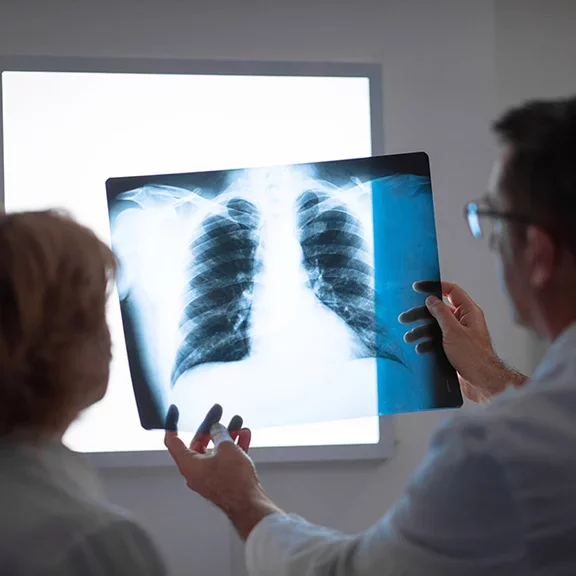Cardiovascular effects of respiratory rehabilitation in COPD
Study of the pathophysiological mechanisms explaining the loss of cardiovascular prevention effects of exercise training in patients with respiratory failure
Chronic obstructive pulmonary disease (COPD) is a chronic inflammatory disease with a pulmonary origin, but is systematically associated with co-morbidities, notably cardiovascular. Treatment is based on respiratory rehabilitation, one component of which is exercise training. However, in COPD patients, retraining does not improve vascular function, especially in the respiratory failure stage. Approximately 200,000 patients reach the stage of respiratory failure in France*. Dr Farès Gouzi's team at the Montpellier University Hospital is trying to identify the mechanisms involved in the lack of vascular response to exercise training. The objective is to propose a therapeutic solution.
COPD and cardiovascular comorbidities
COPD is systematically associated with comorbidities that worsen its prognosis. Atherosclerotic cardiovascular disease is the most common and most serious comorbidity. It is characterized by damage to the artery walls which can obstruct the passage of blood and the supply of oxygen to the tissues, thus leading to myocardial infarction, arteritis of the lower limbs, stroke, etc. In total, cardiovascular co-morbidities account for 50% of hospitalizations and 25% of deaths of COPD patients. Until recently, these cardiovascular diseases were attributed to the patients' smoking, but recent publications now question this dogma. Currently, the international scientific community has become aware of the urgency of studying cardiovascular disease in COPD and in particular in patients with chronic respiratory failure*.
A vascular anomaly is currently the subject of major interest: endothelial dysfunction, i.e. the damage to the cells lining the arteries. In fact, this anomaly precedes the onset of atherosclerosis, and is believed to be reversible. This anomaly is therefore a prime target for research on cardiovascular comorbidities in COPD.
Cardiovascular comorbidities account for 50% of hospitalizations and 25% of deaths in COPD patients*
Exercise training and respiratory rehabilitation
Regular physical exercise or exercise retraining is a therapeutic solution to improve the quality of life of patients. This is usually integrated into a more global program of "respiratory rehabilitation". In the era of "sport as prescription", the beneficial effects of exercise on the cardiovascular system are very widely established. However, the team under Dr. Gouzi as well as other research teams have shown that the cardiovascular effects of exercise training are blunted or absent in patients with COPD*. Whereas endothelial dysfunction is an early and reversible impairment, the effect of exercise is highly inconsistent in COPD. The team led by Dr. Farès Gouzi is seeking to understand the reasons for this at the clinical and cellular level, in particular the role of vascular stem cells involved in the manufacture and maintenance of vessels. The objective is to propose a therapeutic solution to restore a cardiovascular prevention effect of respiratory rehabilitation.
*Gouzi F, Prefaut C, Abdellaoui A, Roudier E, de Rigal P, Molinari N, Laoudj-Chenivesse D, Mercier J, Birot O, Hayot M. Blunted muscle angiogenic training-response in COPD patients versus sedentary controls. Eur Respir J 2013; 41: 806-814.
Gouzi F, Maury J, Bughin F, Blaquière M, Ayoub B, Mercier J, Perez-Martin A, Pomiès P, Hayot M. Impaired adaptation of training-induced blood pressure in COPD patients: implication of the muscle capillary bed? --- International Journal of Chronic Obstructive Pulmonary Disease 2016; 11: 2349–2357.
Influence of chronic hypoxemia on the vascular response to exercise
The loss of the vascular effects of exercise would mainly concern COPD patients with chronic respiratory insufficiency*. Respiratory failure is established when the pulmonary system is unable to oxygenate the blood. This is called hypoxemia.
Researchers at the Montpellier University Hospital are exploring the mechanisms of this endothelial dysfunction by studying vascular biomarkers and vascular stem cells collected by simple blood sampling. Indeed, this innovative methodology allows researchers to non-invasively obtain vascular cells that have all the abnormalities present in COPD patients, and to study their functioning in vitro, in normal or oxygen-depleted environmental conditions (in order to mimic the chronic hypoxia of patients).
For this research, two groups of people undergo an exercise training program: a first group of healthy subjects and a second group of COPD patients with respiratory insufficiency and without respiratory insufficiency. The evolution of biomarkers of endothelial damage is studied after 4 weeks of re-training. In patients whose endothelial function has not been improved by training, it will be possible to demonstrate the role of different factors, such as chronic hypoxia.
In addition, researchers will study the function (proliferation, differentiation, etc.) and cell signaling pathways of vascular stem cells obtained before and after re-training, in normoxic conditions and in a hypoxic chamber. Thus, Dr. Gouzi's team hopes to highlight the role of hypoxia in vascular biological responses to exercise in hypoxic COPD patients.
What the Air Liquide Foundation is doing
The Air Liquide Foundation is financing the consumables necessary for the research work and the exercise training sessions.



